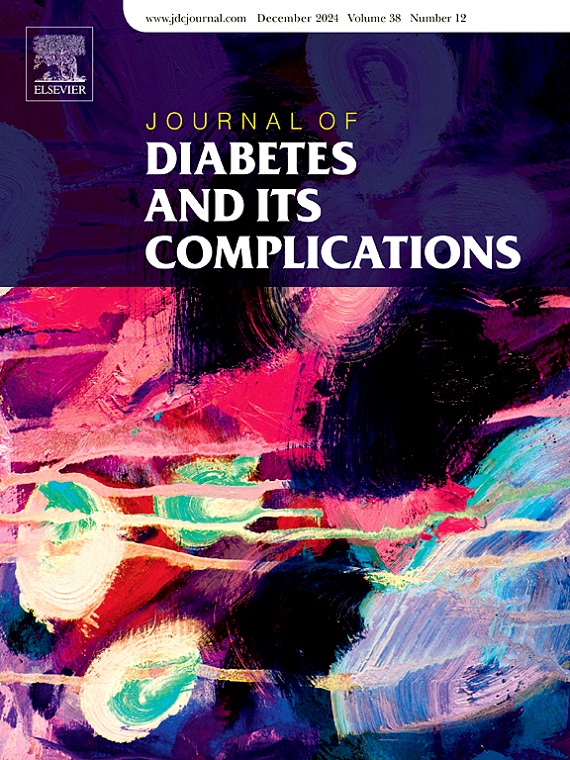Sex specific associations of sex hormones with brain volumes and cerebral blood flow: A cross sectional observational study within the look AHEAD type 2 diabetes cohort
IF 3.1
3区 医学
Q3 ENDOCRINOLOGY & METABOLISM
引用次数: 0
Abstract
Background
Females have greater brain volume and cerebral blood flow than males when controlling for intracranial volume and age. Brain volume decreases after menopause, suggesting a role of sex hormones. We studied the association of sex hormones with brain volume, white matter hyperintensity volumes and cerebral blood flow in people with Type 2 Diabetes and with overweight and obesity conditions that accelerate brain atrophy.
Methods
We analyzed data from 215 participants with overweight or obesity and Type 2 Diabetes from the Look AHEAD Brain Magnetic Resonance Imaging ancillary study (mean age 68 years, 73 % postmenopausal female). Estradiol and total testosterone levels were measured with electrochemoluminescence assays. The ratio of brain measurements to intracranial volume was analyzed to account for body size. We analyzed sex hormones as quantitative measures in males, whereas in females we grouped those with detectable vs. undetectable hormone levels (Estradiol <73 pmol/L [20 pg/mL]: 79 %; Total Testosterone <0.07 mmol/L [0.02 ng/mL]: 37 % undetectable in females).
Results
Females with detectable total testosterone levels had higher brain volume to intracranial volume ratio (median [25th, 75th percentile]: 0.85 [0.84, 0.86]) as compared to those with undetectable Total Testosterone levels (0.84 [0.83, 0.86]; rank sum p = 0.04). This association was attenuated after age and body mass index adjustment (p = 0.08). Neither white matter hyperintensity volumes or cerebral blood flow in females, nor any brain measures in males, were significantly associated with Estradiol or Total Testosterone.
Conclusions
In postmenopausal females with Type 2 Diabetes with overweight and obesity, detectable levels of total testosterone were associated greater brain volume relative to intracranial volume, suggesting a protective role for testosterone in female brain health. Our findings are limited by a small sample size and low sensitivity of hormone assays. Our suggestive findings can be combined with future larger studies to assess clinically important differences.
Trial registration
NCT00017953
性激素与脑容量和脑血流量的性别特异性关联:前瞻性2型糖尿病队列的横断面观察研究
背景在控制颅内容量和年龄时,女性的脑容量和脑血流量比男性大。绝经后脑容量减少,这表明性激素的作用。我们研究了性激素与2型糖尿病患者脑容量、白质高强度体积和脑血流量的关系,以及超重和肥胖加速脑萎缩的情况。方法:我们分析了来自Look AHEAD脑磁共振成像辅助研究的215名超重或肥胖和2型糖尿病患者的数据(平均年龄68岁,73%绝经后女性)。用电化学发光法测定雌二醇和总睾酮水平。脑部测量值与颅内容积的比值被分析以解释身体尺寸。我们对男性的性激素进行了定量分析,而在女性中,我们将激素水平可检测到的和不可检测到的进行了分组(雌二醇& 73 pmol/L [20 pg/mL]: 79%;总睾酮& 0.07 mmol/L [0.02 ng/mL]: 37%,女性无法检测到)。结果总睾酮水平可检测的女性脑容量与颅内容积比(中位数[25,75百分位]:0.85[0.84,0.86])高于总睾酮水平不可检测的女性(0.84[0.83,0.86],秩和p = 0.04)。年龄和体重指数调整后,这种关联减弱(p = 0.08)。无论是女性的白质高强度体积或脑血流量,还是男性的任何脑部测量,都与雌二醇或总睾酮无关。结论在绝经后伴有超重和肥胖的2型糖尿病女性患者中,总睾酮检测水平与较大的脑容量相关,提示睾酮在女性脑健康中起保护作用。我们的发现受到样本量小和激素检测灵敏度低的限制。我们的提示性发现可以与未来更大规模的研究相结合,以评估临床上重要的差异。审判registrationNCT00017953
本文章由计算机程序翻译,如有差异,请以英文原文为准。
求助全文
约1分钟内获得全文
求助全文
来源期刊

Journal of diabetes and its complications
医学-内分泌学与代谢
CiteScore
5.90
自引率
3.30%
发文量
153
审稿时长
16 days
期刊介绍:
Journal of Diabetes and Its Complications (JDC) is a journal for health care practitioners and researchers, that publishes original research about the pathogenesis, diagnosis and management of diabetes mellitus and its complications. JDC also publishes articles on physiological and molecular aspects of glucose homeostasis.
The primary purpose of JDC is to act as a source of information usable by diabetes practitioners and researchers to increase their knowledge about mechanisms of diabetes and complications development, and promote better management of people with diabetes who are at risk for those complications.
Manuscripts submitted to JDC can report any aspect of basic, translational or clinical research as well as epidemiology. Topics can range broadly from early prediabetes to late-stage complicated diabetes. Topics relevant to basic/translational reports include pancreatic islet dysfunction and insulin resistance, altered adipose tissue function in diabetes, altered neuronal control of glucose homeostasis and mechanisms of drug action. Topics relevant to diabetic complications include diabetic retinopathy, neuropathy and nephropathy; peripheral vascular disease and coronary heart disease; gastrointestinal disorders, renal failure and impotence; and hypertension and hyperlipidemia.
 求助内容:
求助内容: 应助结果提醒方式:
应助结果提醒方式:


